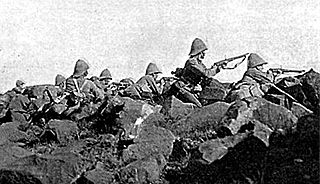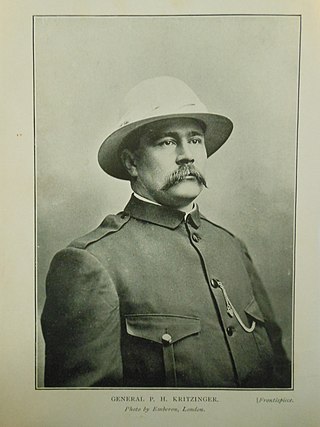
The Second Boer War, also known as the Boer War, Transvaal War, Anglo–Boer War, or South African War, was a conflict fought between the British Empire and the two Boer republics over the Empire's influence in Southern Africa.

The Battle of Spion Kop was a military engagement between British forces and two Boer Republics, the South African Republic and the Orange Free State, during the campaign by the British to relieve the besieged city Ladysmith during the initial months of the Second Boer War. The battle was fought 23–24 January 1900 on the hilltop of Spioen Kop(a), about 38 km (24 mi) west-southwest of Ladysmith and resulted in a Boer victory.

The siege of Ladysmith was a protracted engagement in the Second Boer War, taking place between 2 November 1899 and 28 February 1900 at Ladysmith, Natal.

The Battle of Modder River was an engagement in the Boer War, fought at Modder River, on 28 November 1899. A British column under Lord Methuen, that was attempting to relieve the besieged town of Kimberley, forced Boers under General Piet Cronjé to retreat to Magersfontein, but suffered heavy casualties altogether.

The Royal Northumberland Fusiliers was an infantry regiment of the British Army. Raised in 1674 as one of three 'English' units in the Dutch Anglo-Scots Brigade, it accompanied William III to England in the November 1688 Glorious Revolution and became part of the English establishment in 1689.

The SecondBattle of Colenso, also known as the Battle of Colenso, was the third and final battle fought during the Black Week of the Second Boer War. It was fought between British and Boer forces from the independent South African Republic and Orange Free State in and around Colenso, Natal, South Africa on 15 December 1899.

The Battle of Paardeberg or Perdeberg was a major battle during the Second Anglo-Boer War. It was fought near Paardeberg Drift on the banks of the Modder River in the Orange Free State near Kimberley.

The Battle of Magersfontein was fought on 11 December 1899, at Magersfontein, near Kimberley, South Africa, on the borders of the Cape Colony and the independent republic of the Orange Free State. British forces under Lieutenant General Lord Methuen were advancing north along the railway line from the Cape to relieve the siege of Kimberley, but their path was blocked at Magersfontein by a Boer force that was entrenched in the surrounding hills. The British had already fought a series of battles with the Boers, most recently at Modder River, where the advance was temporarily halted.

The Battle of Talana Hill, also known as the Battle of Glencoe, was the first major clash of the Second Boer War. A frontal attack by British infantry supported by artillery drove Boers from a hilltop position, but the British suffered heavy casualties in the process, including their commanding general Sir William Penn Symons.

The Battle of Elandslaagte took place during the Second Boer War, and was one of the few clear-cut tactical victories won by the British during the conflict. However, the British force retreated afterwards, throwing away their advantage.
The Battle of Sanna's Post was an engagement fought during the Second Boer War (1899–1902) between the British Empire and the Boers of the two independent republics of the Orange Free State and the South African Republic.
The 14th Infantry Brigade was a British Army formation during the Second Boer War, World War I, when it served on the Western Front, and World War II, when it fought in Crete and Tobruk, and then as Chindits in Burma.

The Battle of Ladysmith was one of the early engagements of the Second Boer War. A large British force which had concentrated at the garrison town of Ladysmith launched a sortie on 30 October 1899, against Boer armies which were slowly surrounding the town. The result was a disaster for the British. The main body was driven back into the town, and an isolated detachment of 800 men was forced to surrender to Commandant De Wet. The Boers did not follow up their advantage by proceeding towards the strategically important port of Durban, and instead began a siege of Ladysmith, which was relieved after 118 days. John Norwood was awarded the Victoria Cross for his actions during the battle.

The military history of Australia during the Boer War is complex, and includes a period of history in which the six formerly autonomous British Australian colonies federated to become the Commonwealth of Australia. At the outbreak of the Second Boer War, each of these separate colonies maintained their own, independent military forces, but by the cessation of hostilities, these six armies had come under a centralised command to form the Australian Army.

Pieter Hendrik Kritzinger, was a Boer general and Assistant Commandant of the Forces of the Orange Free State and Commander-in-Chief of the Boer Rebel Forces in the Cape Colony and noted guerrilla commander during the Second Boer War who led the Boer invasions of the Cape Colony during the Guerilla Phase of the Second Boer War.
The Natal Field Force (NFF) was a multi-battalion field force originally formed by Major-General Sir George Pomeroy Colley in Natal for the First Boer War. It was later re-established for the Second Boer War (1899–1902) and commanded by Major-General Sir Redvers Buller VC GCB GCMG.

The South Australian Mounted Rifles (SAMR) was a mounted infantry unit of the Colony of South Australia that served in the Second Boer War. The first contingent of South Australian Mounted Rifles was raised in 1899, followed by a second contingent in 1900.

42nd (Hertfordshire) Company was a unit of the Imperial Yeomanry formed to supplement the British Army in the Second Boer War. Raised by the part-time Hertfordshire Yeomanry and largely drawn from its ranks, the company was engaged at the Rhenoster River, in the Brandwater Basin, and in various small engagements round Krugersdorp. It was replaced by a new 42nd Company in 1901.

The Battle of Veertien Strome was a military engagement in the Second Boer War fought near Warrenton, Northern Cape, by Boer troops under Sarel du Toit and British troops under Paul Methuen. Du Toit failed to prevent the British from crossing the Vaal River and entering the South African Republic from the southwest. This British move would be part of Methuen's clearing of the Orange Free State, within the overall military advance on Pretoria.

The Northern Natal Offensive was a military invasion of the Northern region of Natal by the Boers of the Transvaal and the Orange Free State during the Second Boer War. It was part of a larger offensive by the Boers into the British colonies, with other invasions occurring in Bechuanaland and the Cape Colony. The Boers invaded on 12 October, after Paul Kruger had declared war a day earlier. The Boers initially had success with this offensive, besieging Ladysmith, and reaching as far south as Estcourt in November 1899. The goal of the offensive for the Boers was to reach the port city of Durban and the capital of Pietermartizburg in order hopefully force the British into peace negotiations. However, with Redvers Buller's reinforcements arriving that same month, the Boers retreated to the Tugela River. Multiple attempts were made by Buller to relieve Ladysmith, but to no avail. However, the fourth attempt in February 1900 expelled the Boers from their position at the Battle of the Pieters. Scattered fighting from March-May 1900 continued, with the Boers being expelled from Natal completely at the Battle of Laing's Nek. With the Boers out of Natal, the offensive ended.
















